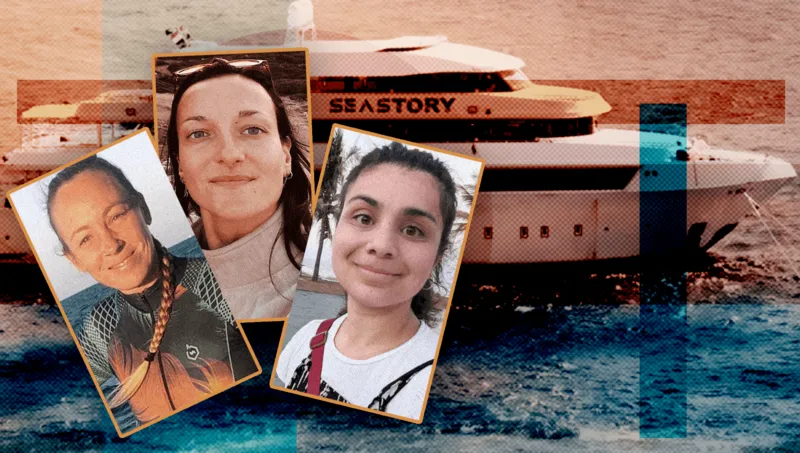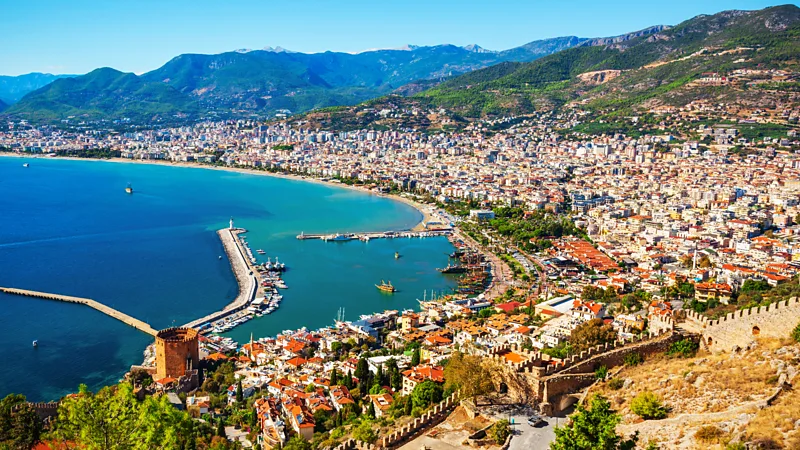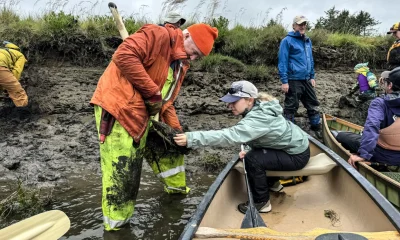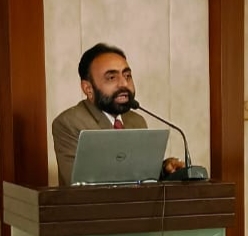Entertainment
The ‘bison skull mountain’ photo that reveals the US’s dark history
The photo of two men standing on a mountain of bison skulls is well known as a symbol of hunting during the colonisation of the US. But there’s a more sinister story behind it – with a surprising modern message.
Two men in black suits and bowler hats pose with a gravity-defying mound of bison skulls. The 19th-Century image is disturbing – thousands upon thousands of skulls piled in neat rows, towering towards the sky. But beneath the macabre first impression, the photo holds a darker secret still. These skulls aren’t just the product of overzealous hunting in the US – and those men aren’t hunters, either.
The skulls, experts say, are the evidence of an organised, carefully calculated campaign to eradicate the bison, deprive Native Americans of a vital resource, and drive the few communities that survived onto small reservations where they could be controlled by the newly arrived white settlers.
“This image is an example of colonial celebration of destruction,” says Tasha Hubbard, a Cree filmmaker who is an associate professor at the Faculty of Native Studies at the University of Alberta in Canada. Hubbard describes the extermination of the bison as a “strategic” part of colonial expansion. The eradication of the animal “was seen as the taming of the West, of domesticating this wild space that was needed in order for expansion of settlement”.
The colonial mass slaughter of bison dealt a lasting blow to tribes that relied on the animal for sustenance. In the aftermath, nations reliant on bison fared measurably, permanently worse than nations that were never bison-reliant, for example suffering from higher child mortality than those other nations, according to a comparative study. The study concludes that the loss set the bison nations on a fundamentally different trajectory that continues to this day.
2:50
Contains some upsetting scenes.
The picture that tells a little-known chapter of America
Native Americans had hunted bison for centuries. For bison nations, it was part of their primarily nomadic culture and the animals provided them with vital sustenance – meat for food, hides for shelter and clothing, and bones for tools. (In common parlance and historical sources, the animals are often referred to as buffalo, as that’s what early settlers called them – though the two are in fact different.)
Indigenous peoples across North America relied on the animal, Hubbard says. “So to remove that keystone species was to weaponise starvation against indigenous peoples: to weaken us in order to control us and remove us from our territories.”
Despite the bisons’ usefulness, estimates put the Native American hunters’ take at less than 100,000 a year, hardly making a dent on the early 1800s population of between 30 and 60 million bison.
By 1 January 1889, there were just 456 pure-breed bison left in the US – and 256 of them were in captivity, protected in Yellowstone National Park and a handful of other sanctuaries.
This photo is not a bracing reminder of the harms of colonial pasts. It is an indictment on commercial consumption practices – Bethany Hughes
The reasons for the mass bison slaughter are numerous: they include the building of three railway lines through the most populous bison areas, which brought new demand for the animal’s hide and meat; modern rifles that made killing bison relatively easy; a lack of protective measures which could have curbed hunting. But there was also more sinister, targeted reason for the animals’ decline than just an increased demand for bison products – more on this later. And even the settlers’ seemingly practical need for bison meat and hide was ultimately intertwined with colonisation and conquest, historians say.
“A desire for wealth and power in the form of land ownership, chattel slavery, the drive for unending growth and profit, and the commodification of natural resources is the reason for the intense overhunting of bison and the political and physical attacks on indigenous nationhood and humanity over five centuries,” says Bethany Hughes, a member of the Choctaw Nation of Oklahoma, and assistant professor at the University of Michigan’s department of Native American studies.
When the Transcontinental Railroad was completed in 1869, it accelerated the decimation of the species. In 1871, a Pennsylvania tannery developed a method of converting bison hides into commercial leather. Swarms of hide hunters decimated central plains herds with a “shocking rapidity”, one study noted.
The infamous image of bison skulls was taken at the Michigan Carbon Works, a refinery that processed bones. There, the bison bones were processed into charcoal that the sugar industry used to filter and purify sugar – the bones were also used as glue and fertiliser.
Entertainment
Trapped in the dark for 35 hours – Red Sea dive-boat survivors tell of terrifying escapes

“By the end, I was just wondering how I would prefer to die.”
Spending 35 hours trapped in a pitch-black air pocket in the upturned hull of a boat has taken its toll on Lucianna Galetta, her voice cracking as she recounts her ordeal.
A video she managed to film briefly using the light on her phone, now shared with the BBC, shows the space where she thought her life might end – and how surging sea water and floating debris prevented her escape
Entertainment
Buy something or leave, Starbucks says

Starbucks says it is reversing rules for its cafes in North America that allowed people to use their facilities even if they had not bought anything.
The changes, which are set to come into force from 27 January, are a U-turn from a policy introduced six years ago that allowed people to linger in Starbucks outlets and use their toilets without making a purchase.
The move is part of the “back to Starbucks” strategy – a plan announced by the firm’s new boss as he tries to tackle flagging sales.
The world’s biggest coffee chain says its new code of conduct – which also addresses harassment and bans smoking and outside alcohol – aims to make its stores more welcoming.
“Implementing a Coffeehouse Code of Conduct… is a practical step that helps us prioritise our paying customers who want to sit and enjoy our cafes”, a Starbucks spokesperson told BBC News.
“These updates are part of a broader set of changes we are making to enhance the cafe experience as we work to get back to Starbucks.”
The company said the new rules will be displayed at every store and staff will be instructed to ask anyone who violates the code of conduct to leave. That includes allowing employees to call the police when necessary.
In 2018, Starbucks decided to allow free access to its coffee shops and toilets after the controversial arrest of two men at one of its Philadelphia cafes.
Other changes set to be introduced later this month include offering one free refill of hot or iced coffee for customers who buy a drink to consume on the premises.
Starbucks has been trying to boost flagging sales as it grappled with a backlash to price increases and boycotts sparked by the Israel-Gaza war.
Brian Niccol, who previously headed the Mexican food chain Chipotle, was brought into Starbucks last year to help turn the business around.
Mr Niccol has been trying to improve the customer experience at Starbucks’ cafes by revamping its menus and coffee shops.
Starbucks said the policy change only applied to North America and not its UK stores.
However, it has not yet responded to requests for comment on the details of its UK policy.
Entertainment
A Turkish film and TV star’s guide to Antalya, Turkey

Actor Ekin Koç called seaside Antalya home before conquering the world of Turkish film. Here are his picks, from hiking the Lycian Road to catching a concert at the Aspendos Theatre.
Though its name may be less familiar to overseas travellers than Istanbul, the Turkish resort city of Antalya is no stranger to visitors. Founded by the Ancient Greeks as Attalia in the 2nd Century BCE, Antalya has since been occupied by the Romans, the Seljuk Sultanate and the Ottomans; even withstanding a brief Italian occupation after World War One before Turkey claimed independence. Today, Antalya – the crowning jewel of the Turkish Riviera and, along with Istanbul, one of the world’s most visited cities in 2023 – attracts both families and A-list celebrities with its 2,000-year-old Old Town and stunning turquoise waters.
Sometimes, the celebrity strolling Antalya’s spectacular seashore is actually a native. We caught up with Antalya-born film star Ekin Koç (best known to English-speaking audiences as Turkish business advisor Kadir in HBO’s Succession) to get his take on his beautiful hometown, studded by the Taurus mountains and cradled by the Mediterranean sea.
“If you’re from Antalya, you have a special connection with the sea,” says Koç. “The sea is everywhere. We eat from the sea, we swim, we sit next to the sea. I’ve always loved being in connection with the sea.”
-

 Entertainment6 months ago
Entertainment6 months agoEarthquake scientists are learning warning signs of ‘The Big One.’ When should they tell the public?
-

 International6 months ago
International6 months agoTarar accuses Imran Khan of conspiring with Faiz Hameed to destabilise Pakistan
-

 International4 months ago
International4 months agoPTI Announces Not to Boycott New Committees
-

 Business4 months ago
Business4 months agoMajor Corruption Scandal Uncovered at WASA Multan: Rs1.5 Billion Embezzlement Exposed
-

 Business6 months ago
Business6 months agoThe Impact of QR Codes on Traditional Advertising
-

 Business3 months ago
Business3 months agoHigh Court Blocks MDCAT Merit List Amid Controversy Over Exam Error
-

 Business6 months ago
Business6 months agoThe Benefits and Problems of International Trade in the Context of Global Crisis
-

 Business5 months ago
Business5 months agoFraud by Pakistani Firm Sparks Outrage in Business Community; Concerns Rise Over International Investment






